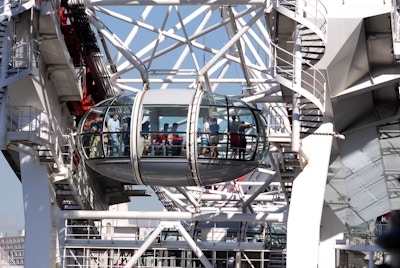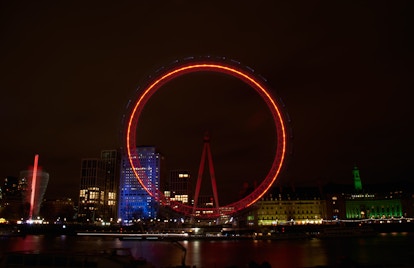- London Theatre Tickets
- Harry Potter London Tours
- Tower of London
- Madame Tussauds London
- Westminster Abbey
- London To Windsor Castle Tours
- Up At The O2 Climb
- SEA LIFE London Aquarium
- London To Stonehenge Tours
- Buckingham Palace
- Tower Bridge
- The Shard
- Frameless London
- Heathrow Airport transfers
- St. Paul's Cathedral
- London City Passes
- National Express London
- Kew Gardens
Top 15 facts about the London Eye that you must know
Top 15 facts about the London Eye

Fourth-largest ferris wheel in the world
The London Eye, at 443 feet tall, is the world's fourth-largest ferris wheel. The wheel's circumference is 1,392 feet, therefore it would be taller than the Shard if it were not a wheel. London is a fairly flat city and the London Eye is a prominent part of the city skyline.

Attracts 3.5 million tourists every year
The London Eye is one of the most popular paid tourist attractions in the United Kingdom, with over 3.5 million visitors per year. This puts the London Eye ahead of ancient global wonders such as Stonehenge and the Great Pyramids of Giza in terms of yearly tourist footfall.

Carries 800 people at once
The London Eye can hold 800 people per revolution, which is the equivalent of the capacity of 11 red double-decker buses in London. With a maximum capacity of 25 people per pod, the London Eye is truly a great way to see the city.

Surreal view up to 40km
The height of the London Eye means that you can see far and wide from the capsule on a clear day. You will be able to see up to 40 kilometers or 25 miles from the London Eye. That means seeing attractions including Buckingham Palace, Wembley Stadium, the Tower of London, and even Windsor Castle.

The wheel never halts
Each round takes about 30 minutes, which means a capsule travels at a leisurely 26 cm per second or 0.9 km (0.6 miles) per hour - just twice as fast as a tortoise sprinting. This sluggish rate of rotation allows guests to jump on and off without having to wait for the wheel to come to a halt.

The London Eye's height is one of a kind
The London Eye stands at a height of 135 meters (443 feet), equal to 64 red telephone boxes stacked on top of each other. This also means that the London Eye has a stupendous circumference. The London Eye will circle 7668 times a year, covering a distance of 2300 miles from London to Cairo, Egypt.

The inspiration behind the London Eye
In response to a 1993 competition inviting Londoners to build a new landmark to commemorate the century, husband-and-wife David Marks and Julia Barfield came up with the idea for the London Eye. The competition was a flop, but Marks and Barfield's concept was a success, and the wheel made its debut on March 9, 2000.

The entire wheel weighs more than 1000 tons
The structure was hoisted into place in September 1999 after being assembled flat and transported onto eight artificial islands on the River Thames. The 32 capsules weigh a total of 1 tonne. To put that sum in context, it is equivalent to 1,157,894 pound coins.

Superstition rules the numbering of capsules
There are a total of 32 capsules, one for each of London's boroughs. They are numbered from 1 to 33 for superstitious reasons, with capsule 13 being left out for good luck. These capsules are capable of accommodating up to 800 guests as well as their selfie sticks so that they can capture the moments.

Largest cantilevered observation wheel
The fact that the Eye is cantilevered, or supported on only one side, sets it apart from other ferris wheels across the world. This is an architectural marvel in its own right. The Orlando Eye in Orlando has a similar construction.

The London Eye has one royal capsule
To commemorate the 60th anniversary of Queen Elizabeth II's coronation, a passenger capsule was dubbed the Coronation Capsule on June 2, 2013. This royal capsule is easily recognizable on the London Eye and is colored red. To date, this is the only one of the 32 capsules that looks different.

The London Eye was supposed to be temporary
The London Eye, like the Eiffel Tower, was intended to be a temporary building. Lambeth Council granted the Eye a permanent license in July 2002. A 25-year lease was signed on February 8, 2006, following a disagreement between the Southbank Centre (which owns the property beneath one of the struts) and the London Eye.

London Eye's fireworks are a global event
The New Year's Eve fireworks at the London Eye are a spectacular event. Just like the Sydney Harbour Fireworks, the marquee event at London's landmark is highly anticipated by local residents and visitors alike. The nearby viewing areas host as many as 150,000 visitors every year and many more on TV screens globally.

The London Eye has witnessed 1000s of proposals
The London Eye is one of the most famous destinations among visitors who want to propose to their partners. The observation wheel has witnessed over 5000 proposals. It has, understandably, been voted one of the most romantic spots in the UK. It is also listed, along with the Eiffel Tower, as one of the most romantic spots in the world.

London Eye is eco-friendly
The use of sustainable oil for the observation wheel and environmentally friendly grease for its moving parts ensures that the ecological balance of the River Thames remains unharmed. Moreover, the adoption of biodegradable cleaning products contributes to a greener surrounding, preventing pollution of the land, air, and water in the vicinity.
Book London Eye tickets
Frequently Asked Questions about the London Eye
London Eye is the world's largest cantilevered ferris wheel, which first started spinning in 2000 to commemorate the millennium.
The London Eye, at 443 feet tall, is the world's fourth-largest Ferris wheel. The wheel's circumference is 1,392 feet.
London Eye is on the South Bank of the river Thames, opposite to Big Ben and the Houses of Parliament.
The London Eye has 32 sealed and air-conditioned capsules, each representing one of the London Boroughs.
Yes, the London Eye can carry 800 people per revolution, which is the equivalent of the capacity of 11 red double-decker buses in London.
The total weight of the wheel and capsules of London Eye is approximately 2,100 tons.
You will be able to see up to a distance of 40 kilometers from atop the London Eye and witness attractions including Windsor Castle, Buckingham Palace, Wembley Stadium, and the Tower of London to name a few.
The London Eye sees nearly 3.5 million visitors per year and is one of the most popular destinations in the UK.
The London Eye completes one rotation approximately every 30 minutes, offering panoramic views of London's skyline.
Yes, the London Eye is committed to sustainability. It uses sustainable oil, eco-friendly grease for its moving parts, and biodegradable cleaning products.
